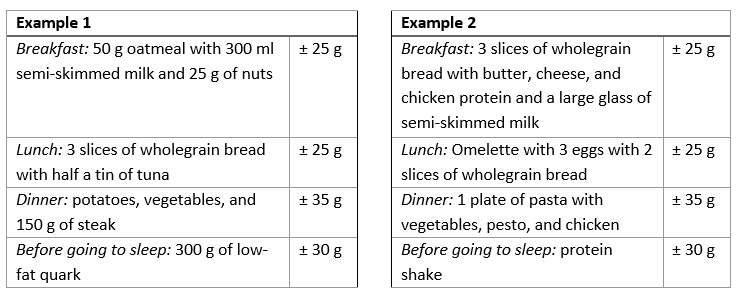Checkout using your account
Checkout as a new customer
Creating an account has many benefits:
- See order and shipping status
- Track order history
- Check out faster
Spreading protein throughout the day: how much and when?
The amount of protein is not the only important aspect of optimally maintaining muscles. The distribution of the total amount of protein over various meals during the day is just as important.
Research shows that the muscles need to be supplied with nutrients multiple times during the day (i.e. amino acids from protein) for optimal muscle growth and recovery. When the optimal amount of protein is consumed, but these are not spread out over the day, part of the potential benefit will be lost. Scientific studies prove without a doubt that four to five portions of protein are required each day for optimal muscle building and recovery.
Based on different studies, a portion of protein of about 20 grams is a good amount to stimulate near-optimum muscle building. A smaller dose will stimulate muscle building to a lesser extent, while a larger portion (up to a maximum of 40 grams) does not make much of a difference. The dose also depends on body weight. More specifically, the general guideline is 0.4 grams of protein per kilogram of body weight per portion. So, for someone weighing 70 kilograms, their portion would be 28 grams of protein per meal. To be completely sure of the optimal amount per meal, you can increase the portion to a maximum of 0.55 grams per kilogram (e.g. 38.5 grams for someone weighing 70 kilograms). You should therefore always ensure that you have sufficient protein at breakfast, lunch, dinner, and one or two snacks at intervals of three to four hours throughout the day to supply new nutrients (amino acids) for muscle building. The tables below provide some practical examples. If the same total amount of protein is spread over more meals or fewer meals, muscle building and recovery will not be optimal.

Protein after exercise
Research shows that muscle growth and recovery is stimulated when a portion of protein is consumed immediately after exercise. This is because physical exertion stimulates the generation of new muscle protein. Eating a high-protein snack immediately after exercise becomes an immediate source of building blocks (amino acids) for muscle growth. In addition, eating the high-protein snack immediately after exercise increases the total amount of protein consumed during the day. So, we recommend that you consume an extra portion of protein immediately after exercise amounting to at least 20 grams or 0.4 grams per kilogram of body weight. Preferably, this protein is of a high quality that is absorbed quickly: ideally whey protein. It is often easy to do so by drinking a protein shake. However, there are also other high-protein products that are an excellent supplement.

A few hours after dinner and before going to sleep, it is important to consume some nutrients in the form of a high-protein evening snack to supply the muscles (see figure above). This under-reported snack time is ideal for increasing the total amount of protein consumed each day and to optimise the distribution of protein over the day. The following blog in this series will go into more detail about the importance of a high-protein evening snack and the practical way to do so, e.g. by consuming a casein supplement.
Summary
In addition to the correct total amount of protein to consume, the distribution of this protein throughout the day is also very important. So, preferably, make sure that your optimal daily amount of protein is distributed over four or five uniform portions of minimally 20 grams so that the muscles receive a continuous supply of nutrients (amino acids) during the day. If you particularly want to increase muscle mass, consume 0.4 to maximally 0.55 grams of protein per kilogram of body weight at each meal or snack. Consume the same dose of protein shortly before going to sleep to stimulate muscle recovery and training progress in the long-term.
References
-
Schoenfeld BJ, Aragon AA, 2018
How much protein can the body use in a single meal for muscle-building? Implications for daily protein distribution. Journal of the International Society of Sports Nutrition, 15(1), 2018. https://jissn.biomedcentral.com/articles/10.1186/s12970-018-0215-1
-
Witard OC, Jackman SR, Breen L, Smith K, Selby A, Tipton KD, 2014
Myofibrillar muscle protein synthesis rates subsequent to a meal in response to increasing doses of whey protein at rest and after resistance exercise. The American Journal of Clinical Nutrition, 99(1), 86-95, 2014. https://www.ncbi.nlm.nih.gov/pubmed/24257722
-
Mamerow MM, Mettler JA, English KL, Casperson SL, Arentson-Lantz E, Sheffield-Moore M, Layman DK, Paddon-Jones D, 2014
Dietary protein distribution positively influences 24-h muscle protein synthesis in healthy adults. The Journal of Nutrition, 144(6), 876-880, 2014. https://www.ncbi.nlm.nih.gov/pubmed/24477298
-
Schoenfeld BJ, Aragon AA, Krieger JW, 2013
The effect of protein timing on muscle strength and hypertrophy: a meta-analysis. Journal of the International Society of Sports Nutrition, 10(1), 53, 2013. https://www.ncbi.nlm.nih.gov/pubmed/24299050
